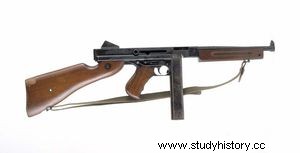Thompson M1

Thompson M1 used in World War II
Country United States
Submachine gun type
Manufacturer Thompson
Date of creation 1943
Ammunition .45 ACP (11.43mm)
Semi-automatic automatic recoil action mode
Rate of fire 700 rounds/minute
Practical range 50 m
Mass (unloaded) 4.78 kg
Length 811mm
Barrel length 267 mm
Straight magazine capacity of 20 and 30 rounds
Thompson M1921

Submachine gun type
Date of creation 1921
45ACP (11.43mm) ammunition
Mode of action delayed recoil semi-automatic automatic
Rate of fire 1000 rounds/minute
Mass (unloaded) 4.69 kg
Length 830mm
Barrel length 267 mm
20 and 30 round straight magazine capacity
50 and 100 round Camembert magazine
Thompson M1928
Submachine gun type
Date of creation 1921
45ACP (11.43mm) ammunition
Mode of action delayed recoil semi-automatic automatic
Rate of fire 700 rounds/minute
Mass (unloaded) 4.99 kg
Length 852mm
Barrel length 267 mm
20 and 30 round straight magazine capacity
50 and 100 round Camembert magazine
The Thompson is an American submachine gun created by John T. Thompson, who bought a patent and founded the Auto Ordnance Corp. in 1916. The first example of the Thompson was built in 1919 and production began in 1921. It was also produced under license in the UK. The weapon was used by the underworld and the police during prohibition. Weapons of AL Capone and Franck Nitty of Clyde Barrow and bonnie Parker (Bonnie and Clyde) It even became a symbol of the period thanks to Hollywood which showed it in action with its famous camembert chargers. However, it was massively used in a simplified version during the Second World War and then during the Korean War.
The Thompson is chambered for the .45 ACP while the majority of submachine guns use the 9mm Parabellum. It can fire either in automatic or semi-automatic mode, except for the M1927 model which only fires in semi-automatic mode.
The first model put into production in 1921 is called M1921. Functioning by delayed recoil, its parts are machined, it has a removable shoulder stock and a second pistol grip placed under the guard.
The second model released in 1923 under the name M1923 is a failed attempt to increase its range by equipping it with a more powerful dedicated ammunition, the .45 Remington-Thompson.
In 1927 a semi-automatic only version of the M1921 was released to supply the civilian market under the name M1927.
The M1928 comes out a year later. Also called Navy Model, it is equipped with a horizontal guard on most models and receives a strap.
In 1943 to meet the constraints of the war, the M1 was put into production. The weapon is simplified, it is now operated directly by recoil, it only receives straight magazines of 20 or 30 rounds. It will be followed by an even simpler version named M1A1.
The machined Thompson was a good quality weapon but expensive to produce, very heavy and with a useful range limited to around 50 yards. One of the very first weapons of its kind, it is a mediocre submachine gun in comparison to later models like the German army's MP40. Its capacity for automatic fire nevertheless remained a guarantee of effectiveness for short-range engagements, although American units preferred the semi-automatic Garand M1 rifle, which was more precise and benefited from a much better extension, or even the M1 carbine, also semi-automatic. automatic, much lighter and more manageable and with a range, which although limited compared to a rifle, was four times greater than that of the Thompson.
